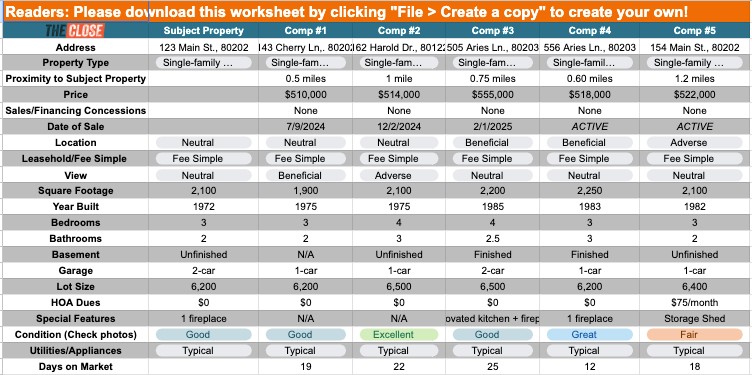A Comparative Market Analysis (CMA) is a crucial tool for both buying and selling real estate. It helps determine a property’s fair market value by comparing it to similar recently sold and actively listed properties (comps). This guide provides a comprehensive walkthrough on how to Do Your Own Comparative Market Analysis.
Step 1: Gather Data on Your Subject Property
Start by collecting detailed information about the property you’re evaluating. This data forms the foundation of your CMA. Utilize public records, MLS data, or online property search tools. An in-person visit is highly recommended to verify information and note unique features. Key data points include:
- Location: Proximity to amenities, urban/suburban/rural classification, flood zone status.
- Year Built: Newer homes often command higher prices due to modern building codes and updated features.
- Property Type: Single-family, condo, multi-unit, townhome, attached/detached, PUD.
- Design and Style: Architectural style, conformity to neighborhood aesthetics.
- Square Footage: Gross living area, total square footage (including unfinished spaces), lot size.
- Room Count: Number of bedrooms and bathrooms, types and features of each (e.g., en-suite bathrooms).
- Amenities and Special Features: Fireplaces, patios, pools, HOA amenities.
- Car Storage: Garage (attached/detached), carport, assigned parking.
- Utilities and Appliances: Standard utility connections, appliance hookups.
- View: Beneficial views (city, park, water) vs. adverse views (parking lot, street).
- Property Rights and Zoning: Fee simple ownership vs. leasehold.
- HOA Dues and Property Taxes: Impact affordability and influence sales price.
- Neighborhood Trends: Analyze recent property value trends, supply and demand, and average marketing time.
- Property Condition: Note needed repairs, safety hazards, and any factors affecting livability.
Example of a CMA Worksheet
Step 2: Research the Market & Choose Comparable Properties
Next, identify comparable properties (comps) – recently sold and actively listed homes similar to your subject property. Focus on:
- Geographic Area: Start with a narrow radius (e.g., 1 mile in urban areas) and expand as needed. Consider proximity to amenities and neighborhood boundaries.
- Key Features: Select comps with similar characteristics to your subject property using the data points from Step 1.
- Date of Sale: Prioritize recent sales (within the past 6 months) for the most accurate market reflection.
- Sales Concessions: Account for any seller concessions that might have influenced the sale price.
Step 3: Evaluate Comps & Adjust for Differences
Rarely will you find identical properties. Adjust for differences between your subject property and the comps:
- Determine Adjustment Amounts: Analyze market data to assign monetary values to differences in features (e.g., extra bedroom, larger lot). Look at price differences between comparable properties with and without specific features to guide your adjustments.
- Make Adjustments: Add or subtract value from the comp’s sale price based on the identified differences to estimate your subject property’s value.
Factors Influencing Market Value
Step 4: Prepare Your CMA Report
Compile your findings into a clear and professional report. Include:
- Subject Property Highlights: Key features, photos.
- Comparable Properties Analysis: Summary of comps, adjustments made, and final value range.
- Neighborhood Profile: Market trends, demographics.
- Market Statistics: Average days on market, price per square foot.
Example of a professional CMA report design.
By following these steps, you can do your own comparative market analysis to gain valuable insights into a property’s market value. Remember, a CMA is an estimate; a professional appraisal is required for official valuations.

